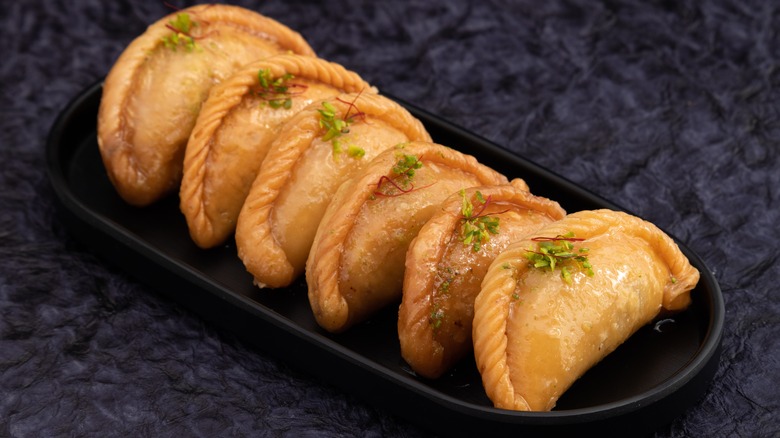The Mysterious Origin Story Behind Eating Gujiya To Celebrate Holi
The Hindu holiday Holi is a symbolic day that encourages observers to cast aside the social hierarchies that keep them apart and come together in an explosion of color and joy. It's iconic for its splashings of dyed water and powder, but Holi is also known for its array of delicious traditional food. Gujiya, a flaky pastry stuffed with sweet fillings, is a treat traditionally served over the holiday, often with a glass of thandai. However, gujiya's origins are somewhat uncertain, with sources connecting its beginnings to Turkey, Central Asia, and the Mughal Empire of the early modern era.
Although the sweet was eaten by Indians as early as the 13th century, its connection to Holi may be more medieval. Nestled in the historic, stunningly beautiful city of Vrindavan, is the Radha Raman temple. Constructed in approximately 1542, the temple is dedicated to Radha-Ramana, the combined form of Krishna and Radha. Their love story is one of the main reasons Holi is celebrated, so it's fair to say the holiday's traditions are observed with gusto in this sacred place. It's supposed that the practice of eating gujiya during Holi caught fire here. These accounts are purely anecdotal, but it's not hard to believe that folks would have been easily encouraged to eat delicious sweets during a day of joy and mirth.
What are the origins of gujiya?
Gujiya also varies from region to region. Other kinds include Maharashtra's karanji and Southern India's nevri. It's not surprising that scholars have found it difficult to pin down gujiya's origins. There are even subtle differences between how these variations are made. For example, karanji contains poppy seeds, dried fruit, and coconut, while nevri is made with coconut and jaggery. One recurrent account states that gujiya was based on a honey-and-jaggery wheat snack eaten by Indians in the 13th century, but this has never been concretely proven.
Central Asian samsa, an early version of the Diwali must-have, samosa, is alleged to have inspired gujiya. This dish, served in Northern India's Mughal Empire during the 15th and 16th centuries, places gujiya's origins much later than the 13th century. However, noted Indian poet Amir Khusrau first documented the samosa as being enjoyed by Indian nobility around the year 1300, implying much earlier beginnings. With that in mind, it's not too far-fetched to suppose that a sweet variation was being enjoyed around the same time.

